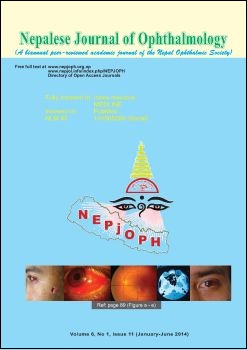Prevalence of various types of allergens in ocular allergic conditions of patients from Pokhara, Nepal
DOI:
https://doi.org/10.3126/nepjoph.v6i1.10759Keywords:
Ocular allergy AKC, VKC, SAC, PAC, skin prick test (SPT), allergen, , specific immune therapy (SIT)Abstract
Introduction: Ocular allergic conditions are mostly recurrent and the drugs prescribed, especially corticosteroids, have serious side effects. Therefore, when maximal tolerated topical and systemic medications are unable to control allergic conjunctivitis, a skin prick test for allergens should be conducted and patients should be taught to avoid these allergens.
Objective: To find out the prevalence of common allergens inciting ocular allergic diseases in Nepal.
Subjects and methods: A total of 13,376 skin prick tests were performed on 76 patients suffering from different chronic recurrent ocular allergic conjunctivitis with 176 common allergens (pollens, fungi, insects, dusts, danders, fabrics/ feathers, food, parthenium leaves, tobacco and mite). Buffer saline was used as a negative control while histamine acid phosphate was used as a positive control. Grading of the skin prick test reaction was done by comparison to the histamine positive control. Only markedly positive reactions were considered positive. Relevant data were entered into the excel spreadsheet and analyzed with the Stata-12 commercial package. The association between allergic conditions and socio-demographic, environmental and other co-variates were tested by the chi-square test.
Results: The common offenders found in the study were mite (42.11 %) followed by fabrics/ feathers (20.39 %), dusts (18.18 %), pollen (17.05 %), non-juicy food (15.02 %), dander (13.60 %), juicy food (11.64 %) and fungus (9.87 %), and tobacco (6.58 %), parthenium leaves (5.26 %) and insects (3.17 %) were less common offenders.
Conclusions: All ocular allergy patients should undergo skin prick tests to find out the allergens causing their allergy and then receive specific immunological treatment (SIT).
DOI: http://dx.doi.org/10.3126/nepjoph.v6i1.10759
Nepal J Ophthalmol 2014; 6 (2): 6-23
Downloads
937
606
Downloads
Published
How to Cite
Issue
Section
License
This license enables reusers to copy and distribute the material in any medium or format in unadapted form only, for noncommercial purposes only, and only so long as attribution is given to the creator.




